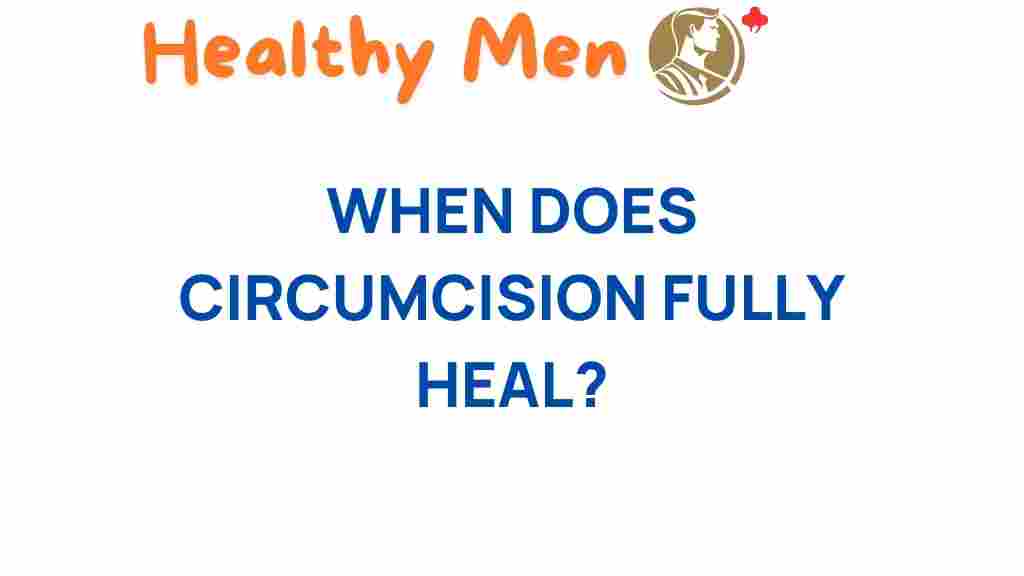Unveiling the Healing Timeline: When Does Circumcision Fully Heal?
Circumcision is a common surgical procedure that involves the removal of the foreskin from the penis. This operation is frequently performed on newborns and infants for various reasons, including cultural, religious, and medical considerations. Understanding the healing time and recovery process is crucial for parents and caregivers to ensure proper post-operative care and to address any potential complications. In this article, we will explore the circumcision healing timeline, discuss the recovery process, and offer valuable insights into male health and infant care.
Understanding Circumcision and Its Purpose
Circumcision is often seen as a routine procedure, but it is essential to understand its implications on male health. Here are some key points regarding circumcision:
- Cultural and Religious Significance: Many cultures and religions, including Judaism and Islam, practice circumcision as a rite of passage.
- Medical Benefits: Some studies suggest that circumcision may reduce the risk of urinary tract infections, sexually transmitted infections, and penile cancer.
- Preventative Measure: Circumcision can also prevent conditions like phimosis, where the foreskin cannot be easily retracted.
The Circumcision Healing Timeline
The healing time after circumcision can vary based on several factors, including the age of the patient, the surgical technique used, and the individual’s overall health. Generally, the recovery process can be broken down into stages:
1. Immediate Post-Operative Phase (Days 1-3)
After the circumcision, the infant or child may experience some discomfort and swelling. Here’s what to expect during this phase:
- Swelling and Redness: It is normal for the area to appear swollen and red. This should gradually decrease.
- Pain Management: Mild pain relief can be provided with over-the-counter medications, as recommended by a healthcare professional.
- Bleeding: Some minor bleeding may occur, which is typically not a cause for concern.
2. The First Week (Days 4-7)
During the first week, the healing process continues, and parents should monitor the surgical site closely:
- Scabbing: A scab will form over the circumcision site, which is a normal part of healing.
- Hygiene: It’s crucial to keep the area clean. Gently wash with warm water and avoid using soaps or lotions that may irritate the skin.
- Diaper Changes: Frequent diaper changes are essential to keep the area dry and prevent infection.
3. The Second Week (Days 8-14)
By the end of the second week, significant healing will have occurred:
- Reduced Discomfort: Most infants will feel much better and may no longer require pain relief.
- Complete Healing of Skin: The external area will start to heal, with less swelling and scabbing.
- Follow-Up Appointment: A follow-up visit with the pediatrician is recommended to ensure proper healing.
4. Full Recovery (Weeks 3-6)
Complete healing of the circumcision site typically takes about 4 to 6 weeks:
- Skin Regeneration: The skin will regenerate, and any remaining scabs will fall off.
- Return to Normal Activities: Normal activities can be resumed, but parents should continue to monitor the area for any signs of complications.
- Long-Term Care: Maintaining good hygiene and regular check-ups will support ongoing male health.
Post-Operative Care: Essential Tips
Proper post-operative care is crucial for a smooth recovery process after circumcision. Here are some tips for caregivers:
- Keep It Clean: Gently clean the area daily with warm water.
- Use Vaseline: Applying a thin layer of petroleum jelly can prevent the diaper from sticking to the surgical site.
- Avoid Tight Diapers: Use loose-fitting diapers to reduce irritation and allow for airflow.
- Monitor for Signs of Infection: Watch for increased redness, swelling, or discharge that may indicate an infection.
Potential Complications and Troubleshooting
While circumcision is generally safe, some complications may arise. It is important to be aware of these potential issues:
- Infection: Signs include increased redness, swelling, and pus discharge. If these symptoms occur, contact a healthcare provider.
- Excessive Bleeding: If bleeding does not stop after applying gentle pressure, medical advice should be sought.
- Foreskin Adhesions: Sometimes the remaining foreskin may adhere to the glans, which might require treatment.
- Pain or Discomfort: If the child seems to be in significant pain beyond the expected discomfort, consult a doctor.
When to Seek Medical Advice
It is essential to consult a healthcare professional if you experience any of the following:
- Signs of infection such as fever, persistent redness, or unusual discharge.
- Severe pain that cannot be managed with medication.
- Bleeding that does not stop with pressure.
- Any concerns regarding the healing process or appearance of the surgical site.
For more information on the circumcision recovery process, consider consulting the American Academy of Pediatrics.
Conclusion
Understanding the healing timeline for circumcision is crucial for ensuring a smooth recovery for infants and children. By following proper post-operative care guidelines, monitoring for complications, and seeking medical advice when necessary, caregivers can support the healing process effectively. Ultimately, knowledge about circumcision and its implications on male health is vital for promoting healthy practices in infant care. Always consult with a healthcare provider for personalized advice and guidance tailored to your child’s needs.
This article is in the category Conditions and created by healthymen Team
